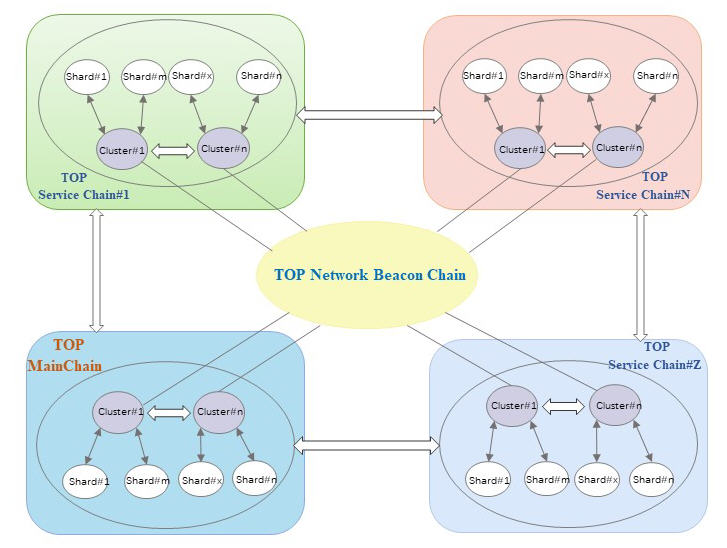# TOP AI Network Infrastructure
# Overview
TOP AI Network is the first fully sharded, entirely permissionless public chain providing high TPS, near instant confirmation times, and low to zero gas fees. Building a chain with these features is very difficult, and requires a multitude of techniques. As a result, we have developed a multi-layer scaling stratagem to accomplish these specifications.
# Overall Design
TOP AI Network adopts a multi-chain architecture. The entire structure of TOP Chain consists of up to 255 level-1 chains, which include the main chain and service chains. Each level-1 chain can itself support up to 255 level-2 sub-chains, and so on. For instance, a developer could branch their own level-2 chain off of the main VPN service chain specifically to support their business.
Level-1 chains are distinct loosely coupled chains. Transactions are routed to the appropriate level-1 chain based on the purpose of the transaction. If it’s for asset transfer, the transaction is routed to the main chain, while if it’s for a type of service transaction, it is routed to the relevant service chain. Each level-1 Beacon Chain is populated from a common set of nodes. Communication between each level-1 chain network is supported by TOP AI Network’s P2P Internet architecture, allowing for efficient communication between nodes across chain networks.

# TOP AI Network Mainchain
The TOP AI Network mainchain adopts multi-sharding, two-layer lattice based on DAG data structure and other expansion technologies, as well as hpPBFT consensus mechanism, so that the single-chain transaction processing capacity reaches 100,000 TPS. See Fullly Sharding Mainchain (Layer-1).
# The Beacon
Like some other sharding architectures, we use a Beacon Chain as part of our design. However, unlike other Beacon Chain implementations, TOP AI Network’s Beacon Chain is very lightweight, and is not involved in confirming the result of the consensus process through methods such as cross-linking. This is the case for Beacon Chains in other sharding projects, which results in them becoming bottlenecks in the system,as all Shards ultimately rely on a single chain to help confirm transactions.
# Beacon Chain Purposes
TOP AI Network’s Beacon Chain has numerous roles, acting as the coordinator and archive for the system. The Beacon Chain handles node registration and elections, along with staking, voting, slashing, and work-load logging. These parameters and processes are logged and handled through Beacon Chain smart contracts. The Beacon Chain also acts as a global clock for the whole system through the production of timing blocks at regular intervals.
# Beacon Chain Nodes
In many sharding systems, the Beacon Chain is run by nodes who must specifically register to act as Beacon Chain nodes. This can result in a shortage of Beacon Chain nodes, as usually most of the mining rewards are distributed to nodes processing transactions. This can ultimately lead to centralization of the Beacon Chain. On TOP AI Network, every advance node is a potential Beacon Chain node by default. The nodes with the highest stake have a higher probability of selection via VRF-FTS algorithm, which means Beacon Chain operations are generally the most secure. To add Beacon Chain blocks and execute Beacon Chain smart contracts, a subset of 256 nodes from the entire pool of nodes is randomly selected for each consensus round.
# TOP AI Network Service Chain
Each business has varying needs and workflows which cannot be satisfied by a single chain. TOP AI Network introduces service chains, which are pluggable chains built for specific use cases. For instance, there will be a VPN service chain, d-storage service chain etc.
Businesses can easily deploy their own personal service chain to fit the needs of their application. More about service chain, please refer to ServiceChainandOne-WayStateChannels(layer-2).
